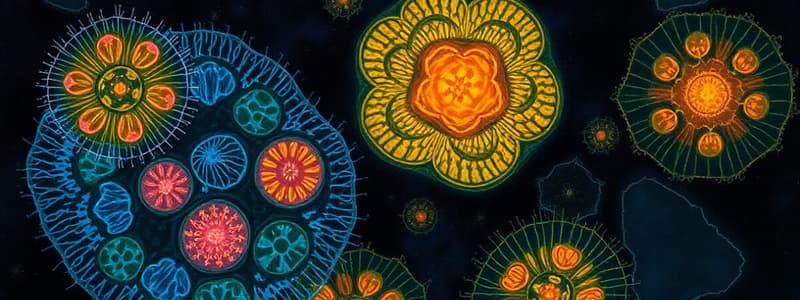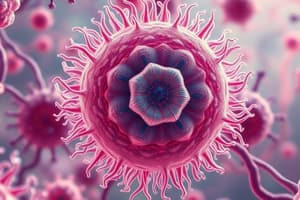Podcast
Questions and Answers
A cell with a diameter of 50μm is observed to be undergoing mitosis. Which type of cell is it?
A cell with a diameter of 50μm is observed to be undergoing mitosis. Which type of cell is it?
- Viral cell
- Bacterial cell
- Eukaryotic cell (correct)
- Prokaryotic cell
Which characteristic is present in eukaryotic cells but not in prokaryotic cells?
Which characteristic is present in eukaryotic cells but not in prokaryotic cells?
- Sexual reproduction involving meiosis (correct)
- Asexual reproduction
- Smaller sized ribosomes within the cytoplasm
- Absence of sterols in the plasma membrane
A researcher identifies a cell that lacks carbohydrates in its plasma membrane. Which type of cell is it most likely to be?
A researcher identifies a cell that lacks carbohydrates in its plasma membrane. Which type of cell is it most likely to be?
- Plant cell
- Prokaryotic cell (correct)
- Fungal cell
- Eukaryotic cell
Which cellular process is exclusive to prokaryotes?
Which cellular process is exclusive to prokaryotes?
A student is comparing and contrasting prokaryotic and eukaryotic cells. They note that one cell type has a cytoskeleton while the other does not. Which of the following statements is correct?
A student is comparing and contrasting prokaryotic and eukaryotic cells. They note that one cell type has a cytoskeleton while the other does not. Which of the following statements is correct?
Flashcards
Binary Fission
Binary Fission
Cell division in prokaryotes where the cell splits into two identical copies.
Mitosis
Mitosis
Cell division in eukaryotes, resulting in two identical daughter cells.
Prokaryote Size
Prokaryote Size
Prokaryotic cells typically range from 0.2 to 2.0 μm in diameter.
Eukaryote Size
Eukaryote Size
Signup and view all the flashcards
Prokaryote Reproduction
Prokaryote Reproduction
Signup and view all the flashcards




